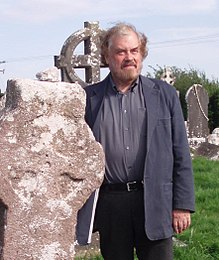In Irish mythology, Abhean, son of Bec-Felmas, was a poet of the Tuatha Dé Danann, and in particular of Lugh. He was killed by Óengus in front of Midir, according to a poem by Fland Mainistreach in Lebor Gabála Érenn.
Dylan ail Don is a character in the Welsh mythic Mabinogion tales, particularly in the fourth tale, "Math fab Mathonwy". The story of Dylan reflects ancient Celtic myths that were handed down orally for some generations before being written down during the early Christian period by clerics. The story as it has been preserved therefore exhibits elements and archetypes characteristic of both Celtic pagan and Christian mythologies. His name translates as "Dylan the Second Wave."
Nicholas Jonathan Anselm Williams, sometimes credited as N. J. A. Williams, is a leading expert and poet in the Cornish language.
The Celtic calendar is a compilation of pre-Christian Celtic systems of timekeeping, including the Gaulish Coligny calendar, used by Celtic countries to define the beginning and length of the day, the week, the month, the seasons, quarter days, and festivals.
The modern Celts are a related group of ethnicities who share similar Celtic languages, cultures and artistic histories, and who live in or descend from one of the regions on the western extremities of Europe populated by the Celts.
The Sister Fidelma mysteries are a series of historical mystery novels and short stories by Peter Tremayne about a fictional detective who is the eponymous heroine of a series. Fidelma is both a dalaigh, and Celtic nun.

Pan-Celticism, also known as Celticism or Celtic nationalism is a political, social and cultural movement advocating solidarity and cooperation between Celtic nations and the modern Celts in Northwestern Europe. Some pan-Celtic organisations advocate the Celtic nations seceding from the United Kingdom and France and forming their own separate federal state together, while others simply advocate very close cooperation between independent sovereign Celtic nations, in the form of Breton, Cornish, Irish, Manx, Scottish, and Welsh nationalism.

Saxmundham is a market town and civil parish in the East Suffolk district, in the county of Suffolk, England. It is set in the valley of the River Fromus about 18 miles (29 km) north-east of Ipswich and 5 miles (8 km) west of the coast at Sizewell. The town is bypassed by the main A12 road between London and Lowestoft. The town is served by Saxmundham railway station on the East Suffolk Line between Ipswich and Lowestoft. In 2011 the parish had a population of 3644.

It is unclear whether a form of Early Irish astrology existed prior to contact with Western astrology, as the earliest Irish language sources are simply translations from standard Western sources. Historian Peter Berresford Ellis argues that although there is evidence of the development of Irish astrology from the 7th Century AD onwards, anything earlier is left to conjecture based on continental Celtic artifacts like the Coligny calendar and reconstructions from historical documents.

Celtic studies or Celtology is the academic discipline occupied with the study of any sort of cultural output relating to the Celtic-speaking peoples. This ranges from linguistics, literature and art history, archaeology and history, the focus lying on the study of the various Celtic languages, living and extinct. The primary areas of focus are the six Celtic languages currently in use: Irish, Scottish Gaelic, Manx, Welsh, Cornish, and Breton.

Brigantia or Brigindo was a goddess in Celtic religion of Late Antiquity.
Bláthnat, sometimes Bláthíne, is a character in early Irish literature, a king's daughter, wife of the warrior Cú Roí and the lover of his rival Cú Chulainn.
Faílbe Flann mac Áedo Duib was a King of Munster from the Eóganacht Chaisil branch of the Eoganachta. He succeeded Cathal mac Áedo Flaind Chathrach of the Glendamnach branch in 628. He was the younger brother of a previous king Fíngen mac Áedo Duib. His sobriquet Flann meant "blood-red".
Colgú mac Faílbe Flaind was a King of Munster from the Eóganacht Chaisil branch of the Eoganachta. He was the son of Faílbe Flann mac Áedo Duib (d.639), a previous king. He succeeded Cathal Cú-cen-máthair mac Cathail as king in 665. The annals mention no details of his reign. His known son was named Nad Froích.
Finguine mac Cathail Con-cen-máthair was a King of Munster from the Glendamnach branch of the Eoganachta. He was the son of Cathal Cú-cen-máthair mac Cathaíl. He succeeded Colgú mac Faílbe Flaind in 678.
Fiannamail mac Máele Tuile was a King of Leinster from the Uí Máil branch of the Laigin. He was the great-grandson of Áed Dibchine mac Senaig, a previous king and grandson of Rónán Crach, possibly the Leinster king mentioned in the saga "Fingal Rónáin".
This is a listing of published works by the historian and novelist Peter Berresford Ellis.

Abbán of Corbmaic, also Eibbán or Moabba, was a saint and abbot. He is associated, first and foremost, with the Mag Arnaide. His order was, however, also connected to other churches elsewhere in Ireland, notably that of his alleged sister Gobnait.
The Ciarraige were a population-group recorded in the early historic era in Ireland.
Onomaris was a Celtic queen regnant. She is described in the anonymous collection of Greek stories known in Latin as Tractatus de mulieribus claris in dello. She is the first Celtic woman mentioned in classical records.






